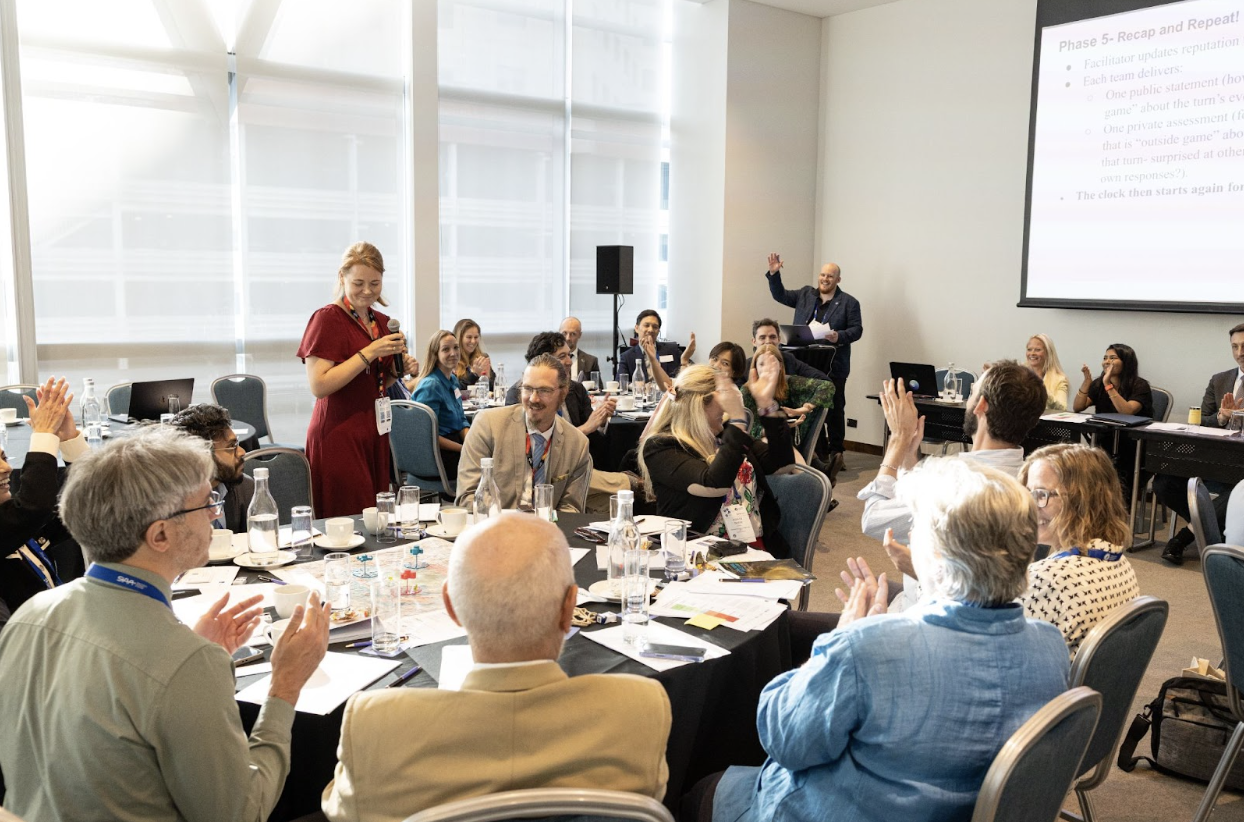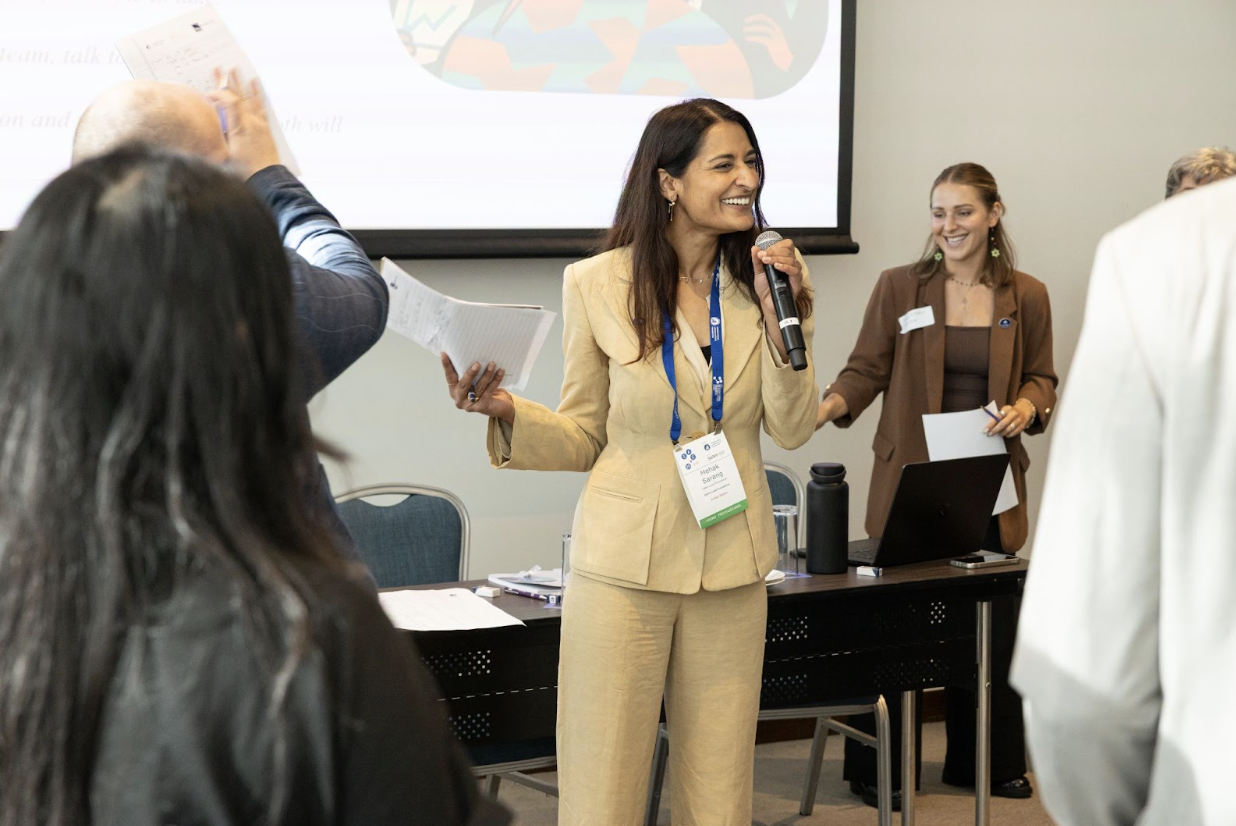Cooperation Beyond Earth: Open Lunar at IAC Sydney 2025
Open Lunar at IAC 2025 — Sydney, Australia
Open Lunar was proud to be on the ground in Sydney for the 76th International Astronautical Congress (IAC). For those who couldn’t join us in person, here’s a recap of what we hosted, shared, and learned during an incredible week of global lunar collaboration.
Our delegation included Rachel Williams, Mehak Sarang, Sam Jardine, and Christine Tiballi. Together, we represented Open Lunar across multiple sessions and events, advancing our mission to make lunar development cooperative, transparent, and values-driven.
Our Objectives at IAC
This year, our goals were to:
Host two major events — the Between the Craters lunar policy simulation and the Lunar Ledger public launch.
Sign key agreements with commercial and institutional partners on the Lunar Ledger, including Firefly Aerospace, ispace, Astrolab, Dymon, and JAOPS.
Announce a new MOU with Honeybee Robotics to advance open dust monitoring and environmental data sharing on the Moon.
Engage with space agencies, researchers, and commercial leaders to share progress and gather insights for the next phase of our initiatives.
Please enjoy this roundup of highlights and reflections from our time at IAC and what they signal about the future of cooperative lunar governance.
Key Insights
The Moon was at the forefront of this year’s IAC. Compared to just three years ago, lunar activity has surged, and it's clear in the representative IAC coverage and also with new startups, experiments, and missions announced almost daily. We’re at a true inflection point for how humanity approaches the Moon.
Across conversations, one theme of hope was clear: actors in the cislunar ecosystem are ready to set positive precedents.
Governments and companies alike are actively asking what “good behavior” looks like in practice — and how transparency and coordination can be built into operations from the start.
We also observed a notable shift in tone around international cooperation. Dialogue across regions, including with China, was constructive and forward-looking — challenging prior assumptions about what collaboration is possible in this new lunar era.
Highlights
Between the Craters: A Lunar Governance Simulation
Summary written by Sam Jardine
On the 30th September, on the sidelines of the International Astronautical Congress (IAC) in Sydney, Open Lunar Foundation, in partnership with Dark Matter Labs, Secure World Foundation, Berggruen Institute, Climate Cartographics, and the Foresight Institute, co-hosted Between the Craters- a high-intensity lunar policy simulation set in the year 2038.
In the scenario, a crisis flared at the fictional Aurora Basin, a volatile and resource-rich region near the lunar South Pole. Competing space powers faced off amid a lack of clear information, ambiguously defined safety zones, dual-use infrastructure, and the first deployment of a nuclear reactor on the lunar surface- all under conditions of limited transparency and growing mistrust.
Over forty participants from government, industry, and academia, including diplomats, scientists, engineers, journalists, and officials from across the world, stepped into roles as competing lunar powers, emerging space nations, populist politicians, and domestic and international media. Across two hours, they navigated a fast-moving crisis where every statement, leak, and headline impacted their governance strategy.
Designing for pressure and ambiguity
Between the Craters was intentionally designed as a stress test for lunar governance- exploring how norms form and fracture when facts are contested, information is incomplete, and political pressure mounts. It was based on the assumption that multilaterally agreed space governance efforts between now and 2038 made no significant progress, and was grounded in current trajectories around geopolitical competition (though assuming that no peer-conflict had erupted between now and 2038) and the rise of political populism globally (both populists themselves, and the impact they on non-populist political groups to meet them on their terms).
Participants operated in a highly asymmetric environment, operating with imperfect information about the activities, intentions, and capabilities of one another on the lunar surface. The two major lunar blocs- the Concordium and the Celestian Pact operated significant lunar infrastructure, including lunar mining, nuclear reactors, and scientific labs, while the emerging Cradle Space Cooperative had only diplomacy, moral authority, and narrative leverage to ensure it wasn’t cut out of lunar governance. Each team faced hidden agendas among their ranks, domestic political pressures, and trade-offs between transparency and strategic advantage.
Core mechanics, including often competing domestic and international reputation trackers, a Lunar Registry for voluntary information sharing, and media-driven framing phases, transformed abstract governance dilemmas into live experience. Players quickly discovered that in a low-trust, unclear information environment, perception becomes as consequential as policy, and even well-intentioned actions risk misinterpretation.
As one participant reflected:
“The simulation made clear that the Moon’s future will be decided as much through storytelling and negotiation as through engineering.”
A diverse and dynamic participant group
The session brought together over forty participants from space agencies, foreign ministries, NGOs, universities, and private space companies, alongside journalists and political advisors. This diversity of expertise was central to the simulation’s success. Scientists debated reactor safety, diplomats argued over precedent and legitimacy, and populist politicians channelled domestic outrage, each bringing their own lens to the unfolding lunar crisis.
Players with experience in multilateral negotiation, including contributors to the Artemis Accords, found themselves navigating new challenges. Others brought scientific insight and engineering realism that grounded the debates in operational detail. The result was a uniquely interdisciplinary environment, where technical, diplomatic, political, and journalistic cultures collided, clashed, and co-evolved in real time.
For many, the simulation was an opportunity to step outside their professional silos and experience how legal norms, public opinion, and strategic competition intersect on the lunar surface. Feedback from the simulation was overwhelmingly positive, with several participants describing Between the Craters as one of the most engaging and revealing policy exercises at IAC.
Insight and learnings
The exercise generated several overarching insights:
Influence in frontier governance depends on negotiation, not dominance. Even without infrastructure, smaller actors can set the tone through procedural creativity and diplomatic leverage, especially between competing great powers.
Transparency is both needed and fragile. Voluntary openness around activities is the very start of trust-building in geopolitically complex environments. It needs to be maintained, institutionalised, and developed carefully to build from.
Information is never neutral. Intelligence-gathering, leaks, and media framing shaped perceptions of responsibility as much as technical behaviour did.
Populism extends off-Earth. Domestic politics and geopolitics repeatedly distorted rational decision-making, revealing how national image-making could drive escalation. Space, like the Arctic and Antarctic, is not immune to these forces, especially as activity increases- governance frameworks need to be robust.
Coalition-building is the new power. Teams that practised multilateralism, building coalitions, reframing legitimacy, and invoking shared treaties, achieved disproportionate influence.
Method and momentum
For Open Lunar and our partners, the simulation reaffirmed the value of immersive policy design and tabletopping/simulations as a method for exploring governance and policy challenges and opportunities. Beyond testing political, geopolitical, legal, and technical frameworks, Between the Craters revealed the emotional and cognitive pressures that real-world decision-makers face in fast-moving, ambiguous environments.
The Open Lunar Foundation is now incorporating insights from the exercise into a case study for Dark Matter Labs’ forthcoming Planetary Compendium, due in November 2025.
Future iterations of Between the Craters are already in discussion, with interest from several participants in running the simulation in partnership with their organisations at other conferences and events, including on the sidelines of UNCOPUOS.
Thank you to all who took part and helped make Between the Craters possible. We look forward to hosting the next one!
Lunar Ledger Public Launch
Summary written by Christine Tiballi
The Lunar Ledger IAC Launch: From Coalition Vision to Momentum
This year, we worked toward one clear goal: launching the Lunar Ledger — the system we’ve been building since May. We debuted it at the International Astronautical Congress alongside our commercial partners, unveiling the world’s first open, coalition-driven platform for tracking and responsibly sharing lunar mission data.
We traveled to IAC with ambition and three dedicated founding partners: Firefly Aerospace, ispace, inc., and Astrolab-Venturi, organizations who closely aligned with our long-held conviction: that lunar activity, if left to fragmented, closed-door negotiation, risks squandering the promise of a sustainable and equitable lunar ecosystem. We left with far more than we imagined possible, both in numbers and signal.
Over the course of the event, the Ledger’s narrative: its technical credibility, governance model, and market-building intent, landed with operators and stakeholders from across the spectrum. During a fireside chat on lunar transparency, another respected space company (SpaceData) openly declared their desire not only to join, but to cement their intent through formal MOUs, right there on the spot. These weren’t casual handshakes for a photo op; these were determined, informed commitments to partner in real time, catalyzed by seeing the platform’s MVP in action and the conviction of the coalition’s founding members.
Momentum didn’t slow. In fact, it accelerated: within two days of the event’s close, two additional industry players officially signed on as Ledger partners JAOPS and Dymon, bringing our signed coalition from three to seven in the span of less than a week. Even more encouraging, further organizations, each with significant lunar ambitions, contacted us with the express goal of formalizing their commitment before year’s end.
What does this surge in coalition-building mean for the mission and for the lunar community at large?
First, it validates a core thesis: The time for a neutral third-party registry and commons-based data infrastructure is not years away, but urgently now. The MVP we brought to IAC was not just a proof of concept, it was a working solution to the day-one pain points voiced by lunar operators: fragmented coordination, safety concerns, and a lack of trusted tools for deconfliction or prospective partnership-building. The positive response made clear that operators recognize the direct benefits of sharing just enough information to build trust and reduce risk, all within a system architected for commercial, scientific, and public value.
Second, it demonstrates that lunar transparency and marketplace development are not at odds. In fact, as we saw during the congress, one is a catalyst for the other. Operators do not want to air proprietary data or competitive strategy in public light; they want clear, standardized protocols for safely signaling intent, reserving resources, and connecting with prospective collaborators or service providers. With the Ledger’s field-level controls, permissioning, and audit trails, participants can opt-in at their own pace, share only what’s necessary, and reap the rewards of a growing lunar marketplace.
The response from the space and technology media underscored just how resonant this moment was for the sector. Our launch and the live signings were quickly picked up by leading industry outlets, including Payload and Space Watch Global. These stories highlighted both the urgency and promise of coalition-driven data transparency for the Moon, framing the Lunar Ledger as “a first-of-its-kind initiative” poised to set new norms for responsible lunar operations and cross-sector collaboration. The positive coverage further fueled incoming interest, showing that the need for an open, trusted registry is not just recognized by mission operators, but by the broader space ecosystem and its observers.
Real impact, of course, is measured not only by early traction but by lasting transformation. In every conversation at IAC, whether with agency representatives, commercial pioneers, or scientific advisors, the same themes emerged: a hunger for credibility, actionable transparency, and solutions that minimize both business and diplomatic risk. Each new signatory brought fresh perspectives and immediate, pragmatic feedback: helping us shape roadmap priorities for the coming year. Their commitment is now inseparable from the future DNA of the Ledger.
Looking ahead, we know that technical platforms alone won’t guarantee responsible and open lunar development. But we now have proof: coalition-based tools can move fast, can attract credible actors, and can lay the groundwork for a marketplace where advantage and accountability are not mutually exclusive. Our next months will be focused on onboarding this next cohort, surfacing their needs, and launching features that deepen both mission assurance and transparency. And later this year, as the Lunar Ledger expands its partnership base, we will continue to invite more organizations to join, not merely as users of a tool, but as stewards and builders of lunar transparency.
We thank our founding partners, our new signatories, and every operator who gave their time, intensity, and candor at IAC. You’ve shown that change: real, operational, and coalition-driven, is possible. The Lunar Ledger stands ready as a nexus, and, as of this moment, the age of lunar marketplace cooperation and trusted transparency has officially begun.
Interested organizations may request a partnership briefing or demo by contacting our team or visiting our website. Let’s build a cooperative and sustainable lunar future together.
Monitoring and Mitigating Dust on the Lunar Surface
Summary written by Mehak Sarang
At the 2025 International Astronautical Congress (IAC), the Open Lunar Foundation and Honeybee Robotics announced a new partnership to develop a dust monitoring system for the lunar surface. This payload will fly on Honeybee’s rover as part of the CP-21 Mission, collecting data on lunar dust behavior and accumulation.
In keeping with Open Lunar’s commitment to open access and shared infrastructure, the payload design and resulting dataset will be made openly available, establishing the foundation for the first open standard for dust detection on the Moon. This initiative will help enable future missions to better understand and mitigate the pervasive challenges posed by lunar dust, advancing safe and sustainable surface operations for all.
Dust posed some of the greatest challenges to operations during the Apollo missions—from coating spacesuits to hindering the mobility of lunar rovers. Apollo astronauts found that fine regolith adhered to their suits and equipment, while optical components became obscured by visible dust layers. During Apollo 12, the lunar module’s landing just 183 meters from the Surveyor 3 spacecraft resulted in a “sandblasting” of the earlier lander, leaving its surface visibly eroded.
These experiences revealed that lunar dust is not just an inconvenience—it’s a fundamental engineering and safety challenge for long-duration surface missions. Understanding how dust moves, settles, and accumulates is essential for designing durable systems and maintaining visibility, safety, and efficiency during lunar operations.
Together, this partnership will develop a standardized model for lunar dust data collection, to be demonstrated on the CP-21 Mission. The goal is to create a repeatable, adaptable payload design that can be integrated into future lunar missions—enabling consistent data gathering across diverse sites and mission types.
Open Lunar brings an approach rooted in governance and precedent-setting through infrastructure development, while Honeybee Robotics contributes deep technical expertise in robotic systems and mechanisms, and direct experience operating in the lunar environment through their recent missions.
As we return to the Moon, sustainable operations are not optional—they are essential. This partnership represents a first step toward that future by building a shared baseline of knowledge that can better inform norms and operations moving forward.
The next phase is collaborative. We invite partners, researchers, and mission planners to join us in developing and deploying similar payload designs across future missions, to build a truly global dataset to better understand and mitigate lunar dust for the benefit of all.
Thank you to all who participated in our IAC 2025
IAC 2025 marked a milestone for Open Lunar, not only in what we launched, but in how we showed up: as a convener of open, responsible, and practical solutions for lunar cooperation.
Stay tuned for more updates as these initiatives evolve — and thank you to everyone who joined us in Sydney.








